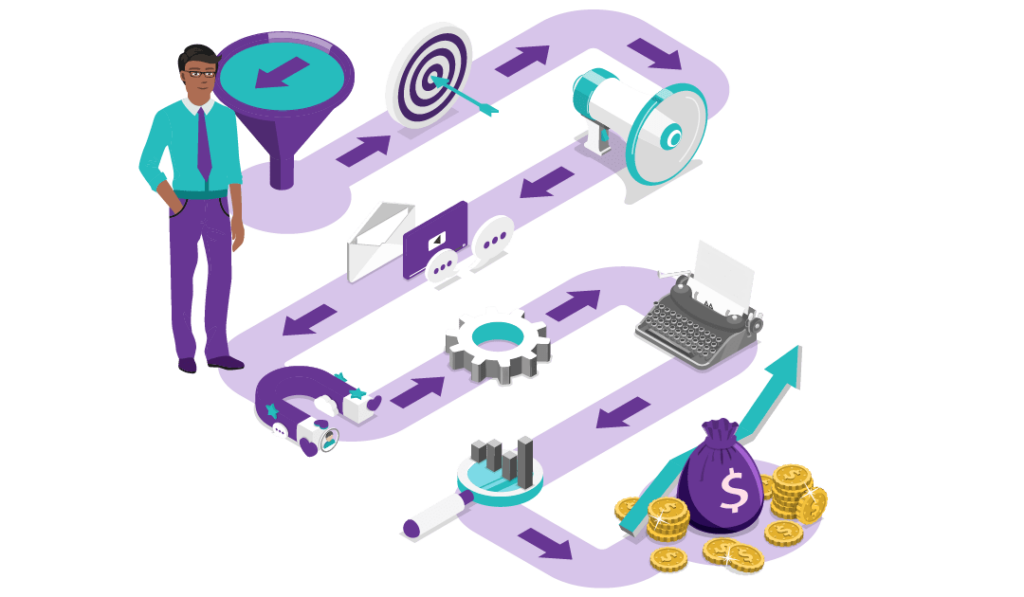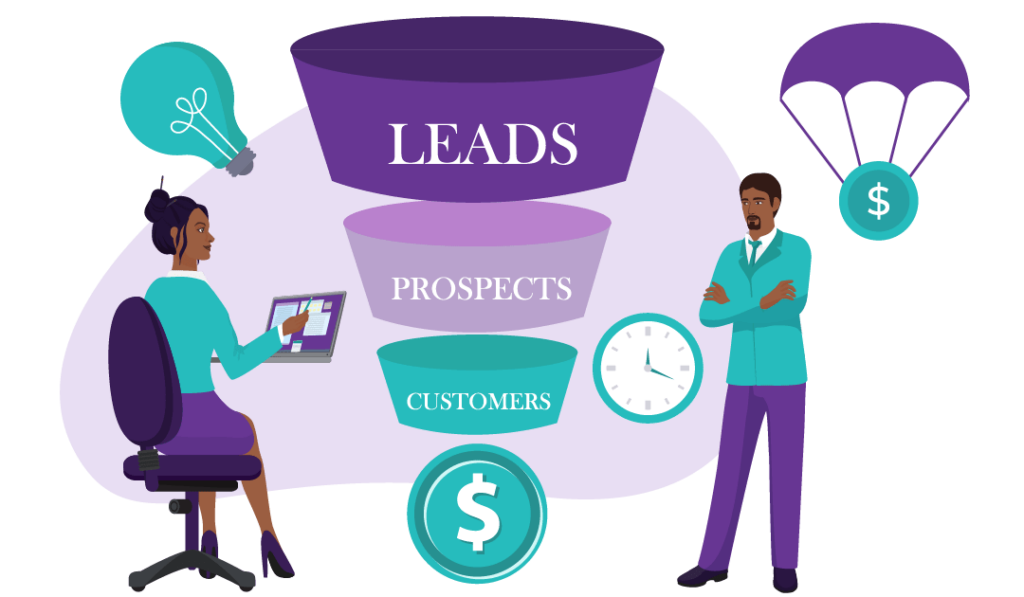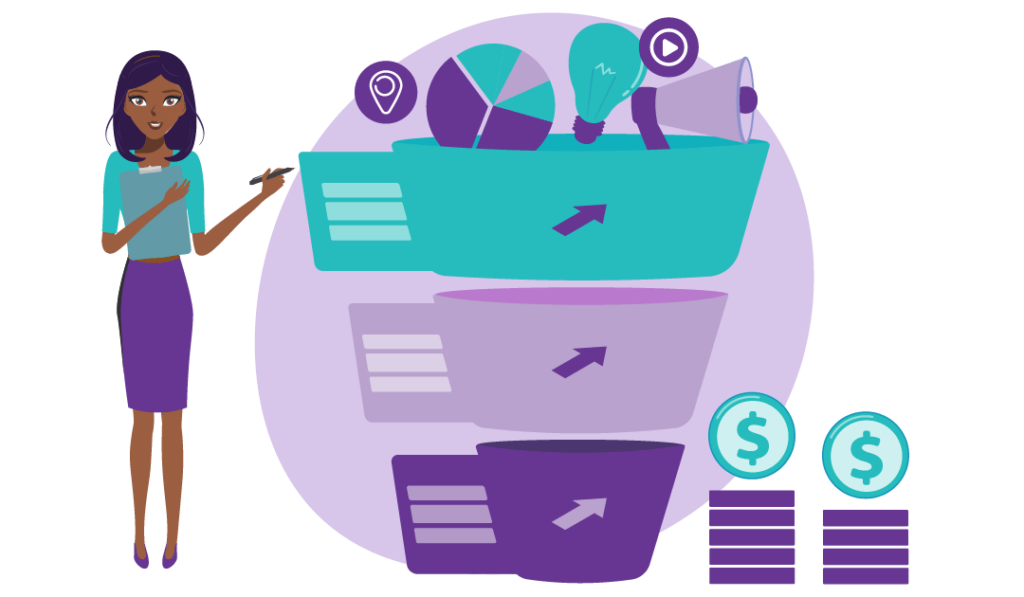What small businesses can learn from big business lead-to-sales conversion rate challenges
Ascend2 and Verse published a very interesting report on the state of lead conversion in marketing and sales. If you think big businesses have lead conversion down pat, think again. Thankfully, this report can help you massively boost your lead conversion without substantial investments of time or money. You just need a good lead conversion strategy.
Now, before I go into the juicy tips you can learn from this report, here’s the background you need to know.
- 277 marketing and sales professionals contributed their views
- 79% of those professionals worked for businesses with more than 100 employees
So bear that background in mind as you absorb the info to come. You can access this great info by reading this article or listening to the audio.
Table of Contents
Lead-to-sales conversion rate satisfaction

Many of us think big brands have it all. In particular, that they have big budgets for everything, so have spent lots of money getting their marketing right.
But according to this report, only 12% of big-business marketing and sales professionals are very satisfied with their lead-to-sales conversion rate.
That leaves a lot of room for improvement.
The consequences of poor lead-to-sales conversion rates

Some businesses think generating lots of leads makes up for a lower conversion rate. And some businesses think they don’t need higher conversions because they don’t have capacity to serve more customers.
That’s flawed thinking.
A poor lead-to-sales conversion rate will reduce your potential revenue, or at least increase the cost of generating that revenue. But that’s not all it does.
A poor lead-to-sales conversion rate will also waste time and resources, lower morale, and if your business is big enough to have separate marketing and sales staff, it can cause tension between the groups.
It’s far cheaper to convert most of your leads than it is to attract heaps of leads but only convert a small number. Improving your conversion rates may also free up resources to enable you to serve more customers, and it might improve staff performance, so your team can get more done in the same amount of time.
Why are your lead-to-sales conversion rates less than desirable?

Before you can improve your lead-to-sales conversion rates, you first need to understand why they’re not as good as you’d like. And if you’re anything like the businesses surveyed in this study, it’s probably because your leads aren’t:
- High quality
- Ready to buy
- The people actually making the purchase decision
You may also have additional challenges. For example, sometimes, you might not be able to get in touch with your leads. There’s also a good chance you or your staff aren’t following up quickly enough.
How many times have you been called by a company months after downloading a lead magnet and not even been able to remember their name? And how many times have you filled in a quote-request form or emailed/called a company for a quote only to have them respond after you’ve given up on them and booked in with one of their competitors? Both these scenarios have happened to me loads of times. If you’re waiting until you have a free slot for a new customer before you follow up with leads, I’ll bet it’s happening to your prospective customers too.
I once even had a client who asked me to run Google ads for them. When I followed up to see how everything was going, it turned out he’d maxed out his bookings and wasn’t even responding to enquiries unless he had a cancellation!
But even if you’re trying to contact leads promptly, you and your staff probably don’t have time to follow up as quickly as you’d like. That was certainly the case for the professionals in this study. Despite the fact that 30% had dedicated lead conversion staff, more than half had a contact or call centre, and more than half had lead conversion software, they still reported losing sales to competitors because they didn’t follow up fast enough.
Obviously following up rapidly is going to be even harder for small businesses that just can’t afford those kinds of luxuries.
How to improve your lead-to-sales conversion rates
Based on that information, there are, as it turns out, probably lots of ways you can improve your lead-to-sales conversion rates without breaking the bank. I’ve pulled together the top four, so you’ve got somewhere to focus your efforts.
- Collect more data on leads. The more you know about your leads, the easier it will be to convince them to buy from you.
- Follow up with leads quickly. If you follow up with leads within a few minutes of lead collection, there’s a good chance they’ll still be on their computer or near their phone, so you’ll have a better chance of getting a hold of them and engaging them. But if you can’t follow up immediately, you still need to follow up before they lose interest, begin to feel like you don’t care about them, and contact your competitors. And you certainly need to follow up before they’ve forgotten who you are. As an added benefit, if you contact your leads promptly, they’ll feel more valued.
- Keep in contact with not-yet-ready leads. A huge proportion of your leads are not going to be ready to buy when they’re first collected. That’s why lead nurturing is so important. Once you’ve made contact with your leads, keep them engaged with your brand and ‘warm’ until they’re either ready to buy or have decided they’re not going to buy from you. (And even then, you may want to keep in touch with them if there’s a good chance they’ll change their mind later — e.g. because you know customers often get bargain regret when they choose one of your cheaper competitors.)
- Filter and funnel leads. Not all your leads find you the same way and not all require the same treatment. If you can sort your leads into groups based on similar characteristics, which is also called segmentation, you can filter and funnel them in ways that are a better fit for each group. The narrower and more clearly defined your segments are, the more personalised your messaging can be and the higher your conversion rates will be.

Ironically, these are among the biggest challenges for most of the marketers and sales professionals surveyed.
When it comes to following up with leads quickly, the challenges are at least understandable. When the staff of 44% of businesses are too busy to follow up with leads and 48% of businesses delegate lead conversion to sales staff, it’s not surprising that it’s difficult to contact leads shortly after they’ve been captured.
But nearly half of all leads are generated outside of business hours, making it even harder to contact leads quickly. If yours is a B2B business, things are a little easier because your prospective customers are more likely to contact you during business hours as it’s part of their job to do so. But for B2C businesses, prospective customers are more likely to contact you after they’ve finished work, which is also usually after your business shuts for the day.
For this reason, choice of communication channel is vital.
How to overcome sales conversion challenges
If your potential customers are contacting you outside of business hours, you need automated methods of responding to them that can be implemented when your staff aren’t on deck. Automation can also help you keep in contact with, and nurture, not-yet-ready leads, collect data about your leads, and funnel your leads.
Here are a few examples of how automation can help.
Automated welcome email sequences that offer excellent value to potential customers are a great way to immediately follow up with leads generated through lead magnets. Additional (personalised) automated email sequences can then deliver valuable problem-solving information and thought leadership to leads, and they can also be used to gather data on leads. You can even build questionnaires into automated email sequences and have your automation software automatically segment leads based on their responses (or lack of response).
Social media and website chat bots, when implemented correctly, can also work wonders under similar conditions. SMS campaigns tend to be more costly than the other options, but are often even more effective in these areas because SMS inboxes generally aren’t overflowing like email and social media inboxes are. In fact, 89% of consumers prefer to communicate with business via SMS. Yet very few businesses are using that communication channel.
Indeed, businesses seem to prefer to use the most labour intensive means of following up and engaging with leads!

Phone calls may be one of the most traditional means of converting leads into sales for high-ticket items, but it’s clearly not the most effective for all businesses. If it were, more businesses would be satisfied with their lead-to-sales conversion rates.
And that’s for businesses that can often afford to hire and train staff that specialise in converting sales by phone. Just imagine what the numbers look like for small businesses.
Part of the problem seems to be a lack of investment in marketing automation software. For instance, only 44% of businesses are using email marketing automation. Yet this kind of software is cost effective and easy to use, and offers such a simple yet effective method of immediately following up with leads, segmenting them and gathering more data from them.
In fact, you can do everything I’ve outlined here with free or nearly free software if your database of leads is small. (And if your database is larger, your financial investment in email marketing software should be more than offset by the extra income you’ll generate as a result of your investment.)
Even more surprisingly, only 39% of businesses were using customer relationship management software. Again, this kind of software is cheap, easy to use and effective for managing the lead follow up, nurturing, and conversion processes.
18% of businesses are using chat bots, which is at least encouraging since that type of software is the newer kid on the block. But clearly, there’s plenty of room for improvement.
And plenty of scope for smaller businesses to learn from these mistakes and consolidate their market positions.
The key to marketing automation success

The big caveat in all of this is that marketing automation only works if your automated sequences are composed of high-quality, strategic assets. That means you need these kinds of resources:
- A comprehensive and actionable marketing strategy and implementation plan that include automated marketing activities
- An engaging, conversion-driven email welcome series and series of email newsletters
- Exceptional chat bot scripts and FAQs based on detailed information about what your ideal customers need from you
- Engaging and conversion-driven SMS ‘newsletters’ and welcome messages
- High quality, valuable content that you can deliver through your lead-nurturing channels and which solve the problems your ideal customers face and position you as a leader and expert in your industry
Eventually, you might even get your systems to the point where an automated engagement system could deliver a blog post, article or other resource for almost every question a prospective lead could ask. But even if you can’t afford an automated system for that, wouldn’t it save you oodles of time if you or your staff could take a few seconds to personalise a template response, add a relevant resource that resolves the query and then hit send, as opposed to spending half an hour or more manually answering every query?
Start boosting your lead-to-sales conversion rate today

Obviously lots of businesses struggle to convert leads into customers as efficiently as they’d like to. But that doesn’t mean the process of improving your lead-to-sales conversion rate has to be long, complicated and expensive.
You can get started right now with these simple steps.
- Find out how many of your customers made their first purchase over the last three months, then divide that by the number of new leads your business secured over the last three months — then multiply the whole lot by 100. That’s your average lead-to-sales conversion rate over the last three months and it’s the number you want to improve upon. Now, schedule time in your calendar at the end of each month to calculate your lead-to-sales conversion rate for that month and start tracking how your rate changes over time.
- Next, find out how many of your leads over the last three months have been contacted by you or one of your staff members. Then…
- For those that were contacted, what was the average amount of time it took to contact them? If it was 48 h or longer, take a look at your processes and develop a plan for reducing that time.
- For those that weren’t contacted, what was the reason they weren’t contact? If you can see any themes, develop a plan for ensuring those things don’t stop you from following up with any more leads.
- Finally, take a look at the questions leads ask you and your staff, and group them according to similarity. Then write a blog post that answers the most popular question and instruct all your staff to share that blog post with anyone who asks that question. If you’ve never written a blog post before or you haven’t been happy with the results of previous attempts, read this guide to the different types of blog posts and what they’re best used for.
Once you’ve done all that, you’ll have taken three simple, entirely affordable steps towards improving your lead-to-sales conversion rate.
If you have any trouble or need help with additional steps, get in touch and I’ll recommend an approach for you.
